
Tourists walk toward the Pyramid of the Moon in Teotihuacan, Mexico. (AP Photo/Gregory Bull)
What would make the discovery of a secret passageway under Teotihuacan’s Pyramid of the Moon even more intriguing? A theory that the tunnel was used to emulate the underworld, to start.
CT scans performed by archaeologists from Mexico's National Institute of Anthropology and History in June indicate that a tunnel about 30 feet underground spans from the pre-Aztec pyramid to the middle of its outer central square, reports Live Science.
They say it's possible the tunnel was used for ritualistic purposes, such as ceremonies marking the different agricultural cycles. "The function of the tunnel may have been to reproduce the underworld, a world where life, animals, and plants originated,” says archaeologist Verónica Ortega, per the International Business Times. Construction began on the Pyramid of the Moon in 100 BC; it was initially a small platform that grew in stages over roughly 500 years to a height of 150 feet. The pyramid is believed to have been the site of human sacrifices and other grisly rituals, indicated by its tombs holding human and animal remains. Researchers believe the tunnel below it may contain artifacts that reveal more about the ancient civilization, but further investigation is needed to confirm the tunnel’s existence before it can be explored. A passageway below the Temple of the Sun, Teotihuacan’s largest pyramid, was discovered in the '70s but had been looted several centuries prior. An interesting side note from the AP: In contrast to other ancient Mexican sites, no remains believed to belong to Teotihuacan's rulers have ever been uncovered. (Meanwhile, a 3,000-year-old prosthetic toe was found in Egypt).
This article originally appeared on Newser: Archaeologists Find Tunnel That May Emulate Underworld




















